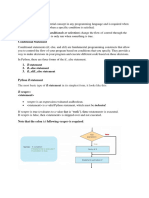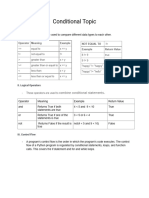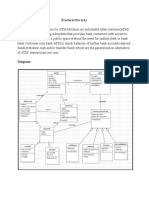0% found this document useful (0 votes)
28 views46 pagesWeek 4 - A Control Structures - Selection
The document covers control structures in Python, focusing on selection statements (if, elif, else) and loops (for, while). It explains the syntax and usage of these structures, including nested conditions and logical operators. Additionally, it provides examples and problem sets to practice the concepts learned.
Uploaded by
Gelo MarananCopyright
© © All Rights Reserved
We take content rights seriously. If you suspect this is your content, claim it here.
Available Formats
Download as PPTX, PDF, TXT or read online on Scribd
0% found this document useful (0 votes)
28 views46 pagesWeek 4 - A Control Structures - Selection
The document covers control structures in Python, focusing on selection statements (if, elif, else) and loops (for, while). It explains the syntax and usage of these structures, including nested conditions and logical operators. Additionally, it provides examples and problem sets to practice the concepts learned.
Uploaded by
Gelo MarananCopyright
© © All Rights Reserved
We take content rights seriously. If you suspect this is your content, claim it here.
Available Formats
Download as PPTX, PDF, TXT or read online on Scribd
/ 46



























































































